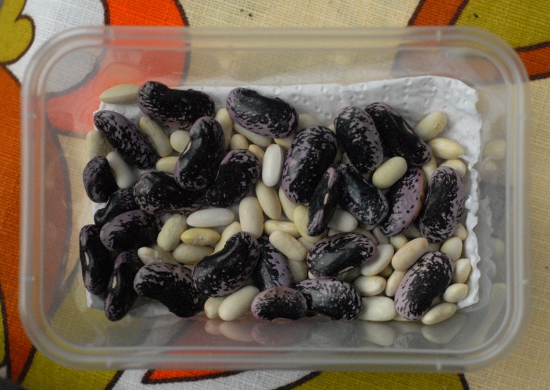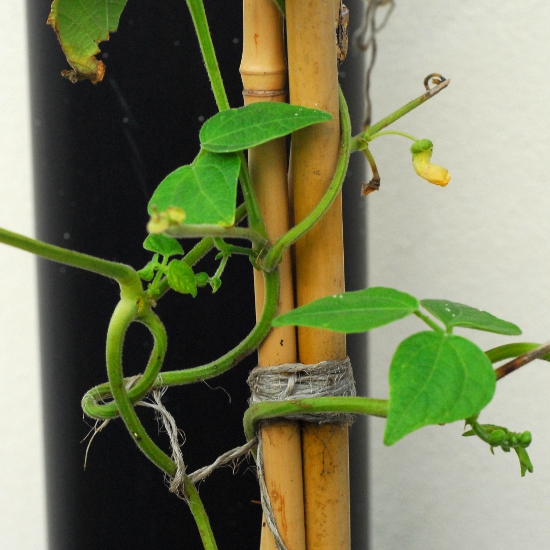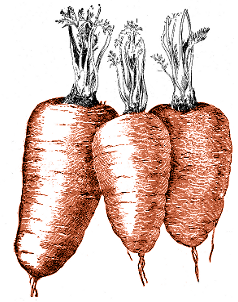Posts tagged ‘saving seed’
Posted in Practicalities on Sunday, February 5th 2012 (6.03 PM).
This afternoon: a seed swapping event at my favourite cinema, The Cube off King Square. I felt rather sheepish going along, because I felt I didn’t have any seeds to take. I do have seeds I’ve saved, but I have no idea at all if any of them are viable, so didn’t feel I could pass them on to the rest of the Bristol gardening community quite yet.
However, it wasn’t a wasted trip, because there was plenty to do besides swap seeds. There was a Compost Cam showing people just how entrancing worms can be to watch; there were taste tests inviting you to spot the home-grown food; and, being a cinema, there were documentary showings. I was particularly interested by one, a BBC documentary from two or three years ago, on the future of farming. In a nutshell: modern farming is doomed. Modern farming needs oil, lots of it, both for combustion engines and for chemical feedstock. As the oil industry declines, modern farming – and the entire modern food economy – will rapidly become unaffordable. All very depressing. The answer, according to the programme, is in seeing biodiversity as an essential part of food production rather than just something that gives us pretty wildlife; in designing agricultural systems which work with rather than against our natural environment; and in a move away from factory-scale agriculture towards smallholdings, because organic smallholdings, run by gardeners rather than farmers, can produce rather more food per acre than an industrial farm can. One thinks here of the Soviet Union, where despite the vast acreage of mechanised kolkhoz and sovkhoz farms, all of the quality food, and a big proportion of the staples, was cultivated on the smallholdings of kolkhoz employees in their spare time and sold in barely-tolerated private markets. Gardeners are better than farmers, it seems. Unfortunately, this is because gardeners devote much more time and attention to each square metre of land than a farmer can, and any sort of smallholding-based solution to the oncoming food supply problem will mean social change at an earth-shattering level.
The other question which comes up regularly in my mind, which the documentary reminded me of, is: just how sustainable, in the long term, is the sort of small-back-garden container gardening that I do? Because, on the face of it, it doesn’t seem to be the healthiest form of gardening. Sustainability is all about generating healthy, fertile soil, soil with its own ecosystem. The ecosystem is needed to replace everything that my plants take away, to replace everything that ends up in my dinner, and if nothing ever goes back into the soil to replace that the soil ends up dead. The general “conventional” guideline for container gardening seems to be: “use fresh compost; grow your plants; your compost is now exhausted”. That process isn’t going to build up any sort of long term sustainability.
I do have some thoughts and ideas about the above: how to make container gardening more sustainable, at the systemic level. The container garden equivalent of the medieval three-field system, maybe. This post is already well into TLDR territory, so those thoughts will come later. In other news, I just hope that the Cube do hold another event next year, when I can donate more to the proceedings myself.
bristol, farming, saving seed, seed, seed swap, sustainability
Posted in Photobloggery, Practicalities, The Old Garden In Bristol on Sunday, December 11th 2011 (3.10 PM).
We missed harvesting the last green beans and runner beans this year, because we had a holiday planned. By the time we got home, they had gone past eating. Still, no point letting them go to waste, so we left the beans on the plant to develop and dry. That was the intention, at least: as the weather became wetter, it didn’t look like there was much chance of them drying successfully on the plant, so we picked them and popped them into a tub in the fridge – unsealed, but covered with kitchen roll. I gathered it would be a good drying-out spot for beans: cold, dark, and naturally drying. Now, a few weeks later, they are dry, hard, and ready to be popped into a storage tin. And they are beautiful: creamy-white green beans and rich, midnight blue and pink runner beans.

It is, really, the whole point of sustainable gardening. We are never going to be self-sufficient, with our little city plot, but equally we don’t want to be restocking our containers with freshly-grown garden centre seedlings each spring when we can raise our own instead. I don’t expect all of these seeds to be viable, but we don’t need many to be viable: this pot could fill our entire garden with beans if we wanted. This isn’t sophisticated breeding: the runner beans are from some spare plants a friend gave us, and the green beans are from some free seeds the BBC was giving out the other year, part of their Dig In project. Being beans, they might not even breed true, but hopefully next year’s bean supply is now in place.
bean, green bean, runner bean, saving seed, seed
Posted in Garden Diary, Photobloggery, The Old Garden In Bristol on Sunday, November 13th 2011 (5.04 PM).
This morning, I came across an interesting article in The Observer: for many plants and animals, spring seems to have come the wrong side of winter. Animals that should be hibernating are waking up again, and plants are still growing strongly and flowering, possibly because the weather has been unusually mild for the season. It prompted me to go outside into the garden, and have a look at the green bean plants, which we had left on their poles, just stems and pods and a few raggedy leaves, so that the beans we had left on the plant could develop and dry naturally ready for next year. Indeed, what did I find on the green beans? Lots of new buds, some of them just coming into flower. Here’s a photo I took this afternoon.

No doubt these flowers are not going to get much further; and they’re definitely not going to set fruit because we’ve not had any bees in the garden for a few weeks now. This weather doesn’t seem quite right, though.
There are a few things I did in the garden this week, largely while K was baking the Christmas cake. See, “just coming into flower” and “baking the Christmas cake” aren’t phrases that go well together at all if you’re north of the Equator. This is what got done:
- Pulling up the last of the radishes.
- Pruning some of the perennial herbs – the thymes, lavender, feverfew, and mint.
- Saving seed that is ready, or almost ready: runner beans, green beans, and coriander.
No doubt I am doing all this at entirely the wrong time of year, but – as far as the pruning was concerned, anyway – it felt like the right time to do it. The beans are for sowing next year; the coriander seeds are probably for the spice cupboard, and the pruned thyme branches were saved for the oven too.
autumn, bean, climate change, coriander, feverfew, green bean, lavender, mint, pruning, radish, runner bean, saving seed, season, seed, thyme



